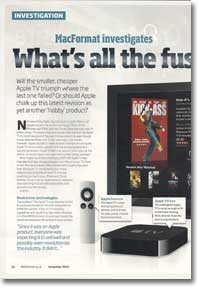
MacFormat investigates the new Apple TV
- Article 87 of 89
- MacFormat, October 2010
Is the smaller, cheaper Apple TV going to triumph where the last one failed?
Page 1 | Page 2 | Page 3 | All 3 Pages
Not everything Apple touches turns to gold. Millions of people around the world have bought Macs, iPods, iPhones and iPads, and the iTunes Store has sold over 10 billion songs, TV programmes and movies. But mention the “Apple TV” to most people and they won’t know what it is, even though it was released three and a half years ago. Last month, however, Apple decided to have another go at turning the Apple TV into a moneyspinner with the announcement of a second generation of Apple TV. Will it be second time lucky?
When Apple launched it in January 2007, the Apple TV was intended to bridge the gap between your Mac and your TV. More or less the same size as a Mac mini and with roughly the same look, the Apple TV connected to your home network and could play in beautiful quality on your TV virtually everything you had in your iPhoto and iTunes libraries. Since it was an Apple product, everyone was expecting it to sell well and possibly even revolutionise the industry.
It didn’t.
The problem was the Apple TV was severely limited. It could only connect to TVs with component or HDMI/DVI sockets. It had no TV-recording capabilities and would only play videos recorded in H.264/MPEG4 format. Its poor spec meant the maximum resolution high def content it could process was 720p, not 1080p. And in the UK, the iTunes Store didn’t offer TV or full-length movies. As a result, the £199 Apple TV was a nice but expensive way to play music and watch your photos on your television screen instead of your Mac.
Over time, the situtation improved. The UK store began to offer movies and TV shows. Mac PVR manufacturers began to offer Apple TV export functions in their software and hardware, and popular encoding software such as Handbrake began to acquire Apple TV presets. Apple added functions like YouTube video watching to the Apple TV as well.
Nevertheless, by the middle of the year, Steve Jobs had downplayed it as a “hobby”.
“Take Two” was the Apple TV’s grand relaunch in January 2008. As well as a simplified user interface, the Apple TV could now access the iTunes Store directly so users could buy TV shows and buy or rent high def movies.
But still few were biting, so Apple tried yet again. Version 3.0 of the Apple TV came out in October 2009. This had a completely redesigned user interface that took advantage of widescreen TV screens (see box). But again, there were few new features and so few new reasons to buy an Apple TV.
So Apple had yet another rethink. As he’d decided with Blu-Ray, Steve Job concluded that people don’t want to own things any more: they want to rent them. And so we have Apple TV – generation two
In a lot of ways, the new Apple TV is a better device than the previous model. It’s cheaper: £99 including VAT, which makes it a far easier sell. It’s about the size of a Mac power brick, which given it has its power brick is built-in is impressive. It uses the same Apple A4 that the iPhone and iPad use, rather than the anaemic Pentium M that often caused slow responsiveness and playback in the first generation. It draws only an eighth of the power of the original and with no hard drive, it’s not the furnace that the first Apple TV was. The interface has been refined (see box). It also looks cooler in jet black and uses a new aluminium remote control rather than the old white remote control.
Page 1 | Page 2 | Page 3 | All 3 Pages

